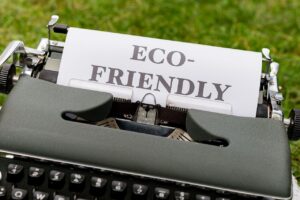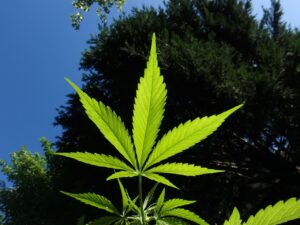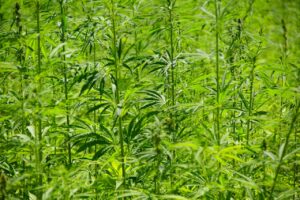The truth about sustainable and biodegradable fabric. Which fabrics are still biodegradable in today’s market? And are they sustainable?

In today’s diverse textile landscape, various natural and synthetic fibers are available, each with unique properties. While some fibers are biodegradable but not sustainable in the long term, others are a mix of natural materials and potentially harmful substances. A distant day ago, traditional fabrics like cotton, wool, hemp, and leather were revered for their exceptional biodegradability, as they could decompose naturally with the assistance of microorganisms. What changed in the landscape? A guess would be capitalism and the introduction of harmful chemical dyes and plastics. So, what is the truth about sustainable and biodegradable fabric?
What is biodegradability?
Biodegradable means bacteria, fungi, or other biological processes can disintegrate an item into its natural base elements. Biodegradation is just nature breaking down materials into their parts. Most plant-based foods are biodegradable in time and will biodegrade with the proper biological settings. Many fabrics can undergo the same process. Biodegradable and sustainable fabric decomposes quickly via the customary course. For fabrics, however, the technique is a tad more convoluted. Depending on the chemicals used on the fibers, such as dispersed dyes, pesticides, and fertilizers the process could take longer. Those chemicals might even damage the environment, the fungi or microorganisms that would usually have helped to break down the fabric. Learn more about disperse dyes in this post.
What is sustainable?

Sustainability science studies the dynamic relationship between humans and the environment, mainly focusing on the coupled human-environment system’s vulnerability, robustness, resilience, and stability (Wu, 2014). In other words, is it maintainable long term? The three pillars of sustainability are environmental, economic, and social. As per the social aspect, plastics are becoming more unacceptable to many for various reasons. The production of plastic is not economically secure. Recycling plastic is the costliest waste management method in the United States. Fossil fuels are not sustainable and are hazardous. A key ingredient in plastic is petroleum.
What fabrics are biodegradable and sustainable?
Different types of biodegradable plant-based fabrics exist, including cotton, hemp, bamboo, abaca, jute, and ramie. Depending on the circumstances, some animal-based fabrics are also biodegradable, but not sustainable. In addition, some blended fibers are semi-biodegradable, depending on the type of blend. It is best to avoid blends with synthetic fibers such as polyester, acrylic, rayon, and many others. Blends with 100% natural fabric are biodegradable, sustainable, and safer for use, assuming harmful chemicals are not present. The truth about sustainable and biodegradable is that man-made fibers are not either.
Cotton – biodegradable and sustainable
Cotton fabric is a fibrous material obtained from the cotton plant. Its texture is soft, fluffy fibers, so it is a harvest favorite. Additionally, it primarily comprises cellulose, an insoluble organic compound crucial to plant structure. Soft and durable is the most often used description of cotton. It is mainly used for apparel but is present in many other products.

There is a downside to farming cotton: it requires lots of water. In addition, most manufacturers use blended fabric containing cotton and other synthetic materials. Thus, ensuring that the garments are 100% cotton is crucial for biodegradability. Some retailers advertise that their product contains 100% organic cotton, but this does not mean the garment’s composition is 100% cotton.
Organic cotton farming is considered healthy and beneficial for the environment. However, genetically modified organisms (GMOs) and fossil fuel-based carbon-intensive fertilizers, pesticides, and herbicides are prohibited in organic farming (Marquis, 2022). Such chemicals make the biodegradable fabric less sustainable.
Bamboo Biodegradable- Mostly

This fabric is created by breaking down the bamboo plant using natural enzymes and weaving it into cloth once it becomes pliable. Bamboo is known for being one of the tallest grass species in the world and is mainly grown in China. It is revered for its rapid growth without the need for fertilizers or pesticides, making it a highly sustainable choice for fabric production. It also requires less water to grow than cotton.
However, farming in China is loosely regulated, allowing farmers to use heavy fertilizers and pesticides to grow bamboo. The heavy use of chemicals can make this fabric less biodegradable and sustainable. Bamboo is often a blend of other natural and synthetic fabrics. Some harmful blends are viscose and rayon, which contain dispersed dyes with toxic chemicals. It’s a great choice to go for a garment that combines bamboo with other natural fibers like organic cotton and linen. Lastly, this combination of fabrics keeps it biodegradable and sustainable.
Hemp Biodegradable

Hemp fabric production embodies a natural biodegradable and sustainable approach. Furthermore, the process begins with the manual cutting and stripping of hemp from the plant, followed by the weaving of the hemp fibers into threads. This traditional technique not only minimizes pollution but also reflects the commitment of hemp farmers to sustainable agriculture. One remarkable characteristic of hemp fiber is its tendency to grow softer with time, enhancing its biodegradability. Hemp, like cotton, is not dyed with dispersed dyes. That is if it is 100% hemp and cotton. A blend of hemp with synthetic fibers contains harmful chemicals.
Linen – Biodegradable

Linen is a strong, sustainable, biodegradable light fabric made from the flax plant. It is naturally hypoallergenic and breathable, making it an excellent textile for warm-weather clothes. Linen is more robust than cotton, dries more quickly, and is more slowly affected by sunlight exposure. Because linen absorbs and releases moisture quickly and is a good conductor of heat, linen garments feel cool to wearers (The Editors of Encyclopaedia Britannica, 1998).
Jute – Sustainable

Jute is a versatile natural plant fiber, also called the “golden fiber of Bangladesh,” derived from the bark of the white jute plant. It is 100% biodegradable, sustainable, and recyclable and is the second most important vegetable fiber after cotton in terms of usage, global consumption, production, and availability (Saad, 2022). The jute plant is a coarse fabric woven into burlap cloth. Its popularity extends to rugs and burlap sacks. Reactive dyes, which are water-soluble and eco-friendly, are the primary dyes for jute. That is until they blend with synthetic fibers and their harmful chemical dyes.
Ramie -Sustainable And Biodegradable

The individual fiber cells are long, averaging 13 to 15 cm (5 to 6 inches). Ramie fiber is pure white, lustrous, moisture-absorbent, and readily dyed. This yarn can be skillfully woven into various textiles, creating diverse fabrics for different purposes. The fiber is more durable than flax, cotton, or wool. Fabric made from ramie fiber is easy to wash, increases strength when wet, and does not shrink or lose form. Repeated washes make this fiber smoother and lustrous. It is also quick to dry. Ramie’s properties make it resistant to mildew and other types of micro-organisms. In addition, prolonged exposure to the sun does not fade the color.
Ramie is in products such as industrial sewing thread, packing materials, fishing nets, and filter cloths. It also creates fabrics for household furnishings and clothing, frequently blended with other textile fibers (The Editors of Encyclopaedia Britannica, 1998a).
Abaca- Biodegradable and Sustainable

Abaca is a durable and sustainable leaf fiber harvested from the Musa textilis plant. It resembles burlap or hemp. Obtaining abaca fibers involves manually stripping and pulping the leaf stalks before thoroughly washing and drying. Furthermore, this incredibly durable and versatile eco-friendly material is predominant in the Philippines and it’s common name is Manila hemp because of its strength and wide-ranging applications. It is biodegradable and sustainable fabric.
Silk -Biodegradable

Silk is a robust and resilient fabric that takes about four years to biodegrade fully. It is hypoallergenic, antimicrobial, antifungal, luxurious, and comfortable. Natural silk is entirely smooth to the touch, with a soft and almost waxy feeling. Furthermore, scrunching this fiber will make a crunching sound, which confirms its silk authenticity. Satin is a luxurious fiber that closely resembles silk. It is a polyester or nylon weave, making it an artificial fabric derived from chemicals, including petroleum. In conclusion, Satin is not biodegradable or sustainable.
Warning: It is undoubtedly not vegan-friendly.
Silk may sound like a silky smooth dream come true, but it is a nightmare for silkworms. Before silkworms become moths, a boiling pot of water awaits these lively silkworms, killing them. Producing 1 pound of silk kills approximately 2,000 to 3,000 silkworms (Egglestone, 2024).
Wool – Biodegradable

Wool is a versatile and natural textile derived from the hair of animals such as sheep, goats, alpacas, and llamas. Various wool fabrics exist, including luxurious cashmere, soft angora, and lustrous mohair. Wool’s added value is for its exceptional insulating, moisture-wicking, and highly durable qualities. The natural lanolin oils in wool make it water-resistant, allowing it to craft outerwear and cold-weather garments like cozy sweaters and protective coats.
The shadow side of the wool:
Animal-based fabrics such as wool, cashmere, leather, and fur are no better than most synthetic fabrics in terms of biodegradability. This fabric undergoes treatment with chemicals and dyes that do not decompose naturally. Due to its high nitrogen content, non-heavily treated wool is biodegradable within a year. However, wool has more issues than just chemical dyes. Like all animal products, harvesting sheep wool takes a toll on the animals and is a highly polluting process for the environment. Therefore, 100% wool is biodegradable, but may not be as sustainable as we like.
Summary The Truth About Sustainable And Biodegradable Fabrics
The natural fibers mentioned earlier utilize specific dyes that differ from dispersed dyes. When combined with other 100% natural fibers, they are not only safer but also biodegradable. Plant-based fabrics are mostly sustainable and biodegradable, mostly. Fabrics that come from animals are biodegradable, but not sustainable. Conversely, if these natural fibers mix with unnatural fibers, they become semi-biodegradable and unsustainable. 100% of synthetic fabrics are non-biodegradable and unsustainable. Use discernment when buying products to steer away from harmful chemicals. In addition, the Federal Trade Commission (FTC) does not require all textiles to have labels and only involves the item’s content. This label does not include the types of dyes or sowing thread fiber. Rule of thumb: If it is a synthetic fiber, it is full of harmful chemicals. Buying natural fibers reduces the possibility of containing harmful chemicals.
Did This Post Sound Contradicting?
It is indeed contradictory. We want to ensure we look at things for what they are objectively. It’s easy to fall into the appeal-to-nature fallacy. For example, just because it’s a plant fiber doesn’t mean it was grown without harmful chemicals. Unfortunately, we at times have to choose between the lesser evil.
Food For Thought…
The consistent consumption of synthetic fibers is an economic incentive for corporations to prioritize their production despite the potential environmental and health implications. Synthetic fibers offer cost advantages over natural fibers, which require higher resource input for production. However, the curious case arises when certain items made entirely of synthetic fibers command premium prices. Is it driven by the brand’s allure or the aesthetic appeal? It’s likely, that both factors play a significant role. So, how do we incentivize corporations to offer healthier options to consumers? Follow me for more on this subject.
The truth about sustainable and biodegradable fabric.
Follow me on:
References
Egglestone, R. (2024, March 25). How is silk made? The ethical dilemma of its origins. Discover Magazine. https://www.discovermagazine.com/planet-earth/silk-making-is-an- ancient-practice-that-presents-an-ethical-dilemma
Marquis, C. (2022, March 4). Gallant International Invests in Farmers to Boost Transparency of its Organic Cotton Products. Forbes. https://www.forbes.com/sites/christophermarquis/2022/03/03/gallant-international-invests-in-farmers-to-boost-transparency-of-its-organic-cotton-products/
Saad, H. A. K. (2022). Biomass Characterization and Insulation Optimization Studies [PhD dissertation, Embry-Riddle Aeronautical University]. In Doctoral Dissertations and Master’s Theses. https://core.ac.uk/download/548997934.pdf
The Editors of Encyclopaedia Britannica. (1998a, July 20). Sclerenchyma | Description, Types, & Function. Encyclopedia Britannica. https://www.britannica.com/science/sclerenchyma
The Editors of Encyclopaedia Britannica. (1998b, July 20). Toile de Jouy | French, 18th-Century, Prints. Encyclopedia Britannica. https://www.britannica.com/topic/toile-de-Jouy
Wu JG, Guo XC, Yang J, Qian GX, Niu JM, Liang CZ, Zhang Q, Li A. [What is sustainability science?]. Ying Yong Sheng Tai Xue Bao. 2014 Jan;25(1):1-11. Chinese. PMID: 24765835.

2 responses to “The Truth About Sustainable And Biodegradable Fabric”
[…] Sustainability ensures that we can meet our current needs without jeopardizing the ability of future generations to meet their own needs. This sustainability requires a more significant focus on reducing the number of items we consume, whether cutting back on single-use plastics, minimizing food waste, or opting for sustainable products. […]
[…] clothing choices limited my ability to express myself and that my current lifestyle habits were not environmentally sustainable. At this stage, I was now angry at myself and the world. Why […]